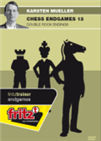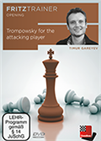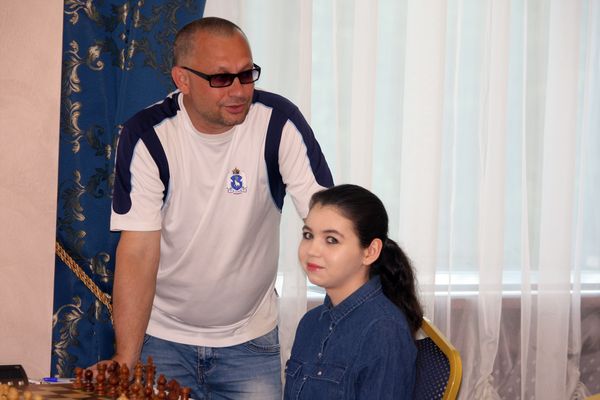As hard-fought as it gets
Few national championships are so highly regarded as the Russian Superfinal. Therefore, the events that decide who plays in the twelve-player round robin are extremely combative. This year, fifty-nine players — with a 2543 rating average — are fighting to get one of the five spots that the tournament awards for the coveted final event. No less than twenty-two of them are rated 2600 or higher.
In such conditions, Alexey Sarana's 4½/5 start is a very impressive feat. To gain some perspective, we can go over last year's tournament, where the two eventual winners — Dubov and Sjugirov — finished the first five rounds "only" with 3½ points. Thus, it is no surprise that Sarana now leads by a full point, with eleven players tied in second place before Sunday's rest day.
To get there, Alexey defeated Artyom Timofeev with the white pieces in the fifth round, in what turned out to be the only decisive game in the first eight boards. A Berlin Defence with 5.Re1 ended up giving White a small but long-lasting grip of the position. With both light-squared bishops still on the board, the pawn structure clearly favoured White. Timofeev tried to hang on, but eventually Sarana's king penetrated the position:
The white rook hast just moved from b1 to e1, and the king is about to go help the c-pawn promote. Timofeev kept going until move 82, but the game was already decided long before.
 Double rook endings occur frequently and are different from single rook endings in several respects.
Double rook endings occur frequently and are different from single rook endings in several respects.
Alexey Sarana and Artyom Timofeev were co-leading the event after four rounds | Photo: Dmitry Kryavkin / Russian Chess Federation
Before beating Timofeev, Sarana had defeated three well-established Russian grandmasters: Dreev, Alekseenko and Khismatulin. The leader's only win with Black so far came in the third round against Alekseenko. Sarana was two pawns down, but the white king's vulnerability was a bigger factor:
The attack was already rolling, but Black's 34...Re3 was vital to seal the deal. After 35.Bxe3, 35...Qf3+ was the beginning of the end for Alekseenko. Sarana converted his advantage flawlessly to sign his second (of four) consecutive wins.
 Tap into your creative mind and start the game on a fresh note. The Trompowsky (1.d4 Nf6 2.Bg5) is an opening outside of conventional wisdom. Create challenges and make your opponent solve problems early on.
Tap into your creative mind and start the game on a fresh note. The Trompowsky (1.d4 Nf6 2.Bg5) is an opening outside of conventional wisdom. Create challenges and make your opponent solve problems early on.Having such a big amount of strong players fighting for only five spots provokes them to show some very creative ideas in order to get ahead, especially during the first rounds. They do not hesitate to get into sharp battles if that is going to leave them closer to the goal, but sometimes this might backfire. Igor Lysyj had just lost to Timofeev in the third round and had achieved to create a double-edge position against his lower-rated opponent Semen Lomasov. Suddenly, however, he found himself in a resignable situation:
Lysyj has just blundered with 30...Qa6. Lomasov, a 2549-rated International Master, played 31.e6 and won the game. The simple idea of blocking the defender of the f6-pawn was the decider.

Evgeny Alekseev is on 3/5 | Photo: Dmitry Kryavkin / Russian Chess Federation
It is really not hard to find instances of incredible tactical skirmishes in an event like this. Unlike the elite supertournaments, players generally are not so afraid about losing prestige or some rating points. For example, 20-year-old David Paravyan beat Klementy Sychev with White from this position:
Black is a pawn up, so White needs to use his initiative quickly if he wants to get the full point. Paravyan followed with 21.Bxg6 Bxg6 22.Nxg6 Kxg6 23.Rg3+. The computer evaluates this as winning for Black, but for human beings it is hard to defend a position with such an open king. In fact, there was a mate-in-5 for White on the board only ten moves later:
 The current openings theory with 1,5 million games
The current openings theory with 1,5 million games
White captures one of Black's only defenders with 33.Rxe5 and wins the game despite being a rook down. After 33...dxe5 34.Qxh5+, Sychev gave up.
Russia has a very high density of strong players in both gender categories. Two female players, Olga Girya and national champion Aleksandra Goryachkina, are playing in the open section, as they have a spot in the Women's Superfinal anyway. Girya started with two losses, but has already bounced back to 50%. Goryachkina, on the other hand, is still undefeated — she drew four games after starting the event with a stunning victory over Evgeny Alekseev:

Current women's Russian champion Aleksandra Goryachkina | Photo: Dmitry Kryavkin / Russian Chess Federation
The players will rest on Sunday, which — luckily for those that like football — coincides with Russia's game against Spain in the FIFA World Cup. After that, Sarana will try to hold on to his post in his game against the experienced player and coach Alexander Motylev.
Tomilova commands the women's section
The Women's Russian Higher League uses the same format as the Open section. Nine rounds of Swiss pairings decide who will be the five players that will have a place in this year's Superfinal. Forty-six participants are fighting to get there.
Elena Tomilova arrived as the 13th seed and started the tournament with four consecutive wins. Her lead is not as big as Sarana's in the Open section, however, as three players are half a point behind with four rounds to go: Evgenija Ovod, Oksana Gritsayeva and Tomileva's sixth round opponent, Tatjana Vasilevich, are on 4/5.

Elena Tomilova just before his fourth round game against Evgenija Ovod | Photo: Dmitry Kryavkin / Russian Chess Federation
Tomilova's most important victory so far came in the fourth round, when she defeated Ovod from the black side of a French Defence. The leader managed to use the open f-file effectively to reach the enemy's king position quicker than her opponent:
After 1.e4 e6 2.d4 d5 3. Nc3 Nf6 4. e5 Nfd7 5. f4 c5 6. Nf3 Nc6 7. Be3, the author takes a detailed look at a daring line with 7... cxd4 8. Nd4 Qb6, as well as the quieter plans with 7...cxd4 8. Nd4 Bc5, and the main line with 7... a6 and b5.
All games - Open
Standings (top 10) - Open
All games - Women
Standings (top 10) - Women
Links























